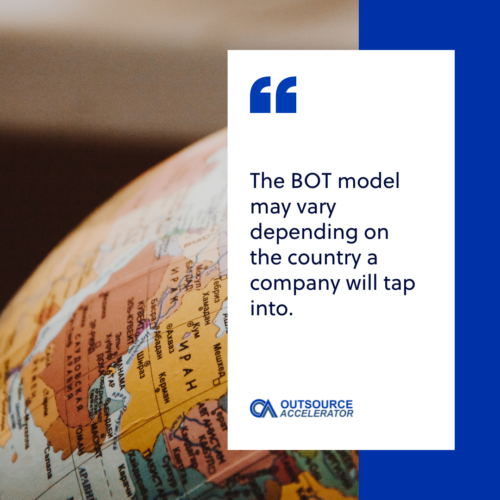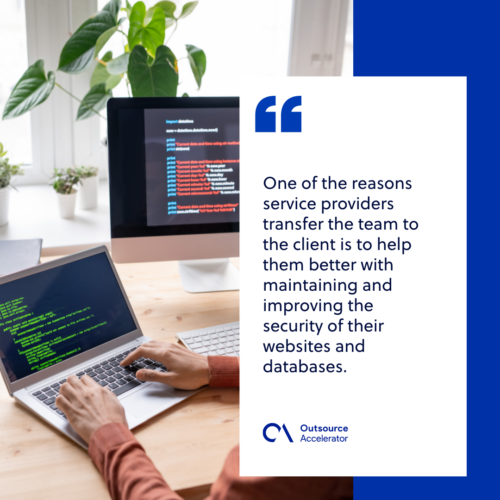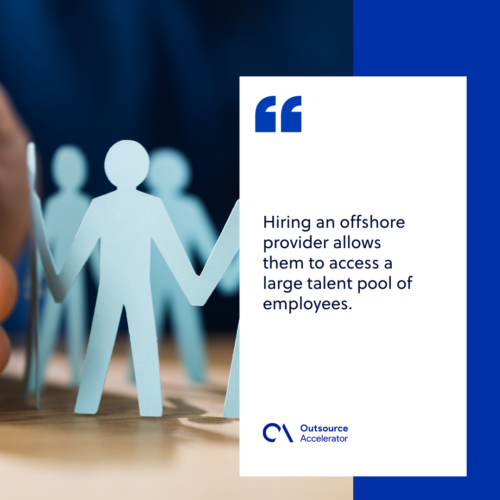How does Build-Operate-Transfer (BOT) work

The build-operate-transfer (BOT) function is not uncommon in outsourcing and offshore staffing relationships. Every client should be aware of it when commencing their outsourcing journey.
In general, the BOT model helps businesses contribute to the economy of a country by putting up infrastructures for the government to attract foreign investors.
With this model, different infrastructures, such as roads, government offices, and public institutions, are built and maintained for public and business use.
However, BOT projects don’t just exist in private and public partnerships. They also gained popularity in outsourcing as a way to expand offshore office operations.
What is build-operate-transfer (BOT)?
Build-operate-transfer (BOT) is a method of financing a project involving two or more parties. It is also a flexible form of outsourcing that combines the elements of the “build” option (insourcing) and the “buy” option (outsourcing).
The term is most common in large infrastructures of real estate companies and public-private partnerships (PPPs) for government infrastructures.
Few countries and locations in the world, such as the Philippines, India, Taiwan, China, and several states in the United States, already practice BOT. Meanwhile, in countries such as Canada and Australia, they use build-own-operate-transfer (BOOT).
What is the difference between public-private partnerships (PPP) and BOT?
Public-private partnerships (PPP) refer to project agreements where a private sector entity takes over the building and operation part of a government-owned infrastructure.
This helps to improve public infrastructures and services in coordination with the private sector. Some of the examples include toll road projects, schools, airports, and government buildings.
PPP involves several forms of participation, including BOT and design-build-operate (DBO). Through these models, the public sector can allow private companies and institutions to invest in infrastructures according to their requirements.

BOT project vs. Concessions
In some common law countries, as per the World Bank, BOT model projects are called concessions. However, the term has a different meaning for most civil law ones.
In a concession, the concessionaire or private entity takes over the management, investment, and revenues generated from a project. They can sell the project directly to consumers without government intervention.
In BOT projects, the project company transfers the project to the public entity or its client.
How build-operate-transfer (BOT) works
In a usual BOT setup, the public sector hires a private contractor to build and operate a facility or infrastructure. The contractor initially finances the project within the agreed-upon project period.
After the facility is complete, the government and the contractor will undergo a purchasing agreement and will open it for “shareholders.” The revenues earned through this purchase will be used for the operation costs, maintenance, and financing costs of the project.
This method usually involves more than two parties. Lenders, suppliers, and construction contractors are also involved in the process.
Variations of build-operate-transfer (BOT)
The method works in several ways, depending on what the project requires.
Build-own-operate-transfer (BOOT)
A company owns and operates the facility to recover the investment costs while gaining margin profit on the project. This method usually involves large infrastructure projects done through private funding.
Build-own-operate (BOO)
Here, a private company builds, owns, and operates a part of a facility with encouragement from the government.
In return, the organization receives financial incentives such as tax-exempt status. This mostly applies to BPO companies in different countries.
Build-lease-transfer (BLT)
Upon completion of a project, the company sets a joint venture agreement with the public sector for the ownership of the facility.
Then they will lease it back for a minimum of 10 years to operate as a business. This is usually common in healthcare facilities and institutions.
Build-lease-operate-transfer (BLOT)
Lastly, in this method, the private organization builds and operates a facility on publicly leased land for a limited time. Once the lease duration is due, the organization transfers back the leased land to the public institution that owns it.

BOT model in outsourcing
BOT in outsourcing, meanwhile, works differently and serves a different purpose. The main role of the BOT model is to help companies set up a separate office in a different country with the help of a local provider.
This model usually involves more common outsourcing forms such as staff leasing or co-sourcing, both of which serve as its starting point. This is most common in information technology (IT) and IT-related projects such as forming a software development team.
Stages of the BOT model in outsourcing
During the first term, the client starts through staff leasing, seat leasing, or business process outsourcing to test the waters. During the early stages, they can choose to incorporate their company culture into their dedicated team.
Once they’re ready to operate on their own, the third party transfers the entire operation to their client.
The “build” stage
During the “build” stage, the third party provides the required documents for renting or leasing an office space.
This includes setting up the internet, electricity, and network for the team. They will also include the equipment needed, such as desktops, phones, and office supplies.
The outsourcing provider then starts hiring the needed employees. They will provide human resource management services such as training, onboarding, documentary compliance, and payroll.
The “operate” stage
The “operate” stage is where the management of the entire operation starts. The project develops along with the leased staff and the office.
The outsourcing provider manages the progress according to the metrics and indicators provided by the company.
Employees also get to improve their skills and knowledge with continuous training and onboarding of tools and services used in their operations.
The company handles the operation for a certain period. Usually, the process takes at least three to five years, depending on their agreed term. After that, when the client is ready, the entire operation, along with the facilities and manpower, is transferred to them.
The “transfer” stage
Lastly, for the “transfer” stage, the company takes over the operation. Here, the outsourcing partner turns over the team, processes, metrics, and office to the company.
The company may still rely on its outsourcing partner for support under a new engagement model or fully take over the operations.
Pros and cons of the BOT model
Pros Cons
Short setup time Long-term employee retention
Shared knowledge and resources Operational retention risks
Access to a larger talent pool Higher transfer rates
Low building and operation risk Cultural differences
Pros of the build-operate-transfer model
- Short setup time: Companies save time and effort in building their team on their own. As a result, they can focus more on building up strategies to make their business grow.
- Shared knowledge and resources: Clients can learn from their service provider about setting up a team. They even share the resources used during building and operation.
- Access to a larger talent pool: Hiring an offshore provider allows them to access a large talent pool of employees. With this, they can have a wider insight into how a task is done.
- Low building and operation risk: With BOT, they won’t have to worry about the documentary requirements they need to build and operate an offshore team. Their service provider will do it for them.
- Enhanced customer experience: Companies using the BOT approach can enhance their customer experience once limited by operating in their own locality.
Cons of the build-operate-transfer model
- Long-term employee retention: Upon transfer, employees now require long-term retention in the company. This setup is not ideal when a role has a specific demand and they decide to scale down.
- Operational retention risks: When a team transfers, companies should comply with a long process of documentation. This consumes time, effort, and expertise since they deal with legalities.
- Higher transfer rates: Some service providers charge a higher rate for BOT. With this, companies should make sure to plan their offshore operations and how they would handle them.
- Cultural differences: Lastly, companies and their offshore teams might experience culture shock since they come from different countries and cultures. To prevent this, companies should get to know their teams and teach their culture to understand each other better.
- Foreign exchange rate risk: Foreign exchange rates in different countries can fluctuate over time. Depending on the economic stability of their offshore destination, this can affect a client’s operating costs.
Commonly outsourced services suited for BOT
Most tasks that can be outsourced can be relevant for BOT. However, not all of these work effectively. Some are better outsourced differently. The most common services applied through BOT include:
Customer service
This is one of the most common services that can be outsourced either through BOT or BPO.
Most companies, to help their customer service team handle their customers better, hire them through BOT. This is to have more hands-on training and supervision to improve their services.
IT network
IT outsourcing through BOT has become popular for tech companies in the West. This includes setting up a cloud network for employees of organizations for a better workflow.
Companies often outsource their IT network management to countries like the Philippines and Poland to save on costs and assure better security.
BOT software development
After being built by an offshore team, software, and system management are turned over to its clients for handling and distribution.
With this, some companies retain the team to do software and system maintenance since they are already involved in the project.
Web development
Like software, web development is usually turned over to the client after setting up. One reason service providers transfer the team to the client is to help them better maintain and improve the security of their websites and databases.
Cons of the build-operate-transfer model
- Long-term employee retention: Upon transfer, employees now require long-term retention in the company. This setup is not ideal when a role has a specific demand, and they decide to scale down.
- Operational retention risks: When a team transfers, companies should comply with a long process of documentation. This consumes time, effort, and expertise since they deal with legalities.
- Higher transfer rates: Some service providers charge a higher rate for BOT. With this, companies should make sure to plan their offshore operations and how they would handle them.
- Cultural differences: Lastly, companies and their offshore teams might experience culture shock since they come from different countries and cultures. To prevent this, companies should get to know their teams and teach their culture to understand each other better.
- Foreign exchange rate risk: Foreign exchange rates in different countries can fluctuate over time. This can affect a client’s operating costs, depending on the economic stability of their offshore destination.
Commonly outsourced services suited for BOT
Most tasks that can be outsourced can be relevant for BOT. However, not all of these work effectively. Some are better outsourced differently. The most common services applied through BOT include:
Customer service
This is one of the most common services that can be outsourced either through BOT or BPO. Most companies, to help their customer service team handle their customers better, hire them through BOT. This is to have more hands-on training and supervision to improve their services.
IT network
IT outsourcing through BOT has become popular for tech companies in the West. This includes setting up a cloud network for employees of organizations for a better workflow.
Companies often outsource their IT network management to countries like the Philippines and Poland to save on costs and assure better security.
BOT software development
After being built by an offshore team, software and system management are turned over to its clients for handling and distribution. With this, some companies retain the team to do software and system maintenance since they are already involved in the project.
Web development
Same with software, web development is usually turned over to the client after setting up. One of the reasons service providers transfer the team to the client is to help them better with maintaining and improving the security of their websites and databases.

BOT model in outsourcing countries
The BOT model may vary depending on the foreign country a company will tap into. While most developing countries practicing this will use the usual BOT, other countries like Canada use build-own-operate-transfer (BOOT) for this.
India
India practices both BOT and BOOT when it comes to public infrastructure projects and private companies.
Both practices help attract foreign investments to the country by improving public services and providing employment to its population.
In BOOT, where private entities own the works first, foreign and local companies take control of the infrastructure and operations, from highways and mass transit to power generation, before letting the government take over after the agreed period.
Meanwhile, BOT is the fastest-growing form of offshoring services in the country, especially in information technology (IT). Companies such as IBM and Google have established operations there through this method.
The Philippines
Meanwhile, the Philippines is heavy on BOT and a few design-build-operate (DBO) projects – especially for infrastructures. This model has helped build roads, mass transport, and even economic zones in the country, which contributed to its development.
Outsourcing companies, meanwhile, have been practicing BOT for both IT and non-IT services. Usually, establishing offshore operations in the Philippines involves creating a reliable SAP team of analysts, consultants, and operation leaders.








 Independent
Independent




